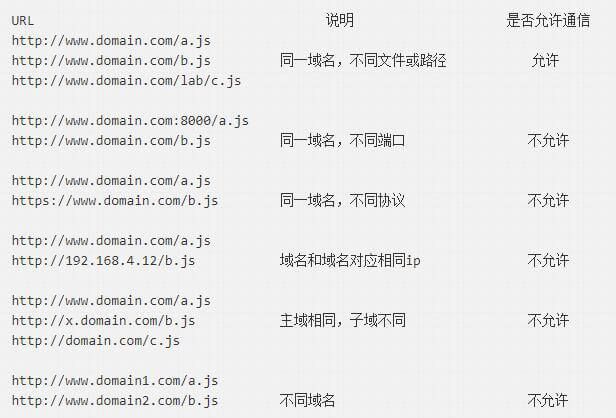文章已同步至掘金:https://juejin.cn/post/6844903912370110472
欢迎访问?,有任何问题都可留言评论哦~
什么是跨域? {#%E4%BB%80%E4%B9%88%E6%98%AF%E8%B7%A8%E5%9F%9F%EF%BC%9F}
跨域是指一个域下的文档或脚本试图去请求另一个域下的资源,这里跨域是广义的。
广义的跨域:
- 资源跳转: A链接、重定向、表单提交
- 资源嵌入: link、script、img、frame等dom标签,还有样式中background:url()、@font-face()等文件外链
- 脚本请求: js发起的ajax请求、dom和js对象的跨域操作等
其实我们通常所说的跨域是狭义的,是由浏览器同源策略限制的一类请求场景。
什么是同源策略?
同源策略/SOP(Same origin policy)是一种约定,由Netscape公司1995年引入浏览器,它是浏览器最核心也最基本的安全功能,如果缺少了同源策略,浏览器很容易受到XSS、CSFR等攻击。所谓同源是指"协议+域名+端口"三者相同,即便两个不同的域名指向同一个ip地址,也非同源。
非同源策略限制以下几种行为:
- Cookie、LocalStorage 和 IndexDB 无法读取
- DOM 和 Js对象无法获得
- AJAX 请求不能发送
常见跨域场景 {#%E5%B8%B8%E8%A7%81%E8%B7%A8%E5%9F%9F%E5%9C%BA%E6%99%AF}

跨域解决方案 {#%E8%B7%A8%E5%9F%9F%E8%A7%A3%E5%86%B3%E6%96%B9%E6%A1%88}
1.通过jsonp跨域
2.document.domain + iframe跨域
3.location.hash + iframe
4.window.name + iframe跨域
5. postMessage跨域
6. 跨域资源共享(CORS)
7. nginx代理跨域
8. nodejs中间件代理跨域
9. WebSocket协议跨域
通过jsonp跨域 {#%E9%80%9A%E8%BF%87jsonp%E8%B7%A8%E5%9F%9F}
通常为了减轻web服务器的负载,我们把js、css,img等静态资源分离到另一台独立域名的服务器上,在html页面中再通过相应的标签从不同域名下加载静态资源,而被浏览器允许,基于此原理,我们可以通过动态创建script,再请求一个带参网址实现跨域通信。
1).原生实现
<script>
var script = document.createElement('script');
script.type = 'text/javascript';
// 传参一个回调函数名给后端,方便后端返回时执行这个在前端定义的回调函数
script.src = 'http://www.domain2.com:8080/login?user=admin&amp;callback=handleCallback';
document.head.appendChild(script);
// 回调执行函数
function handleCallback(res) {
alert(JSON.stringify(res));
}
</script>
服务端返回如下(返回时即执行全局函数):
handleCallback({"status": true, "user": "admin"})
2). jquery ajax:
$.ajax({
url: 'http://www.domain2.com:8080/login',
type: 'get',
dataType: 'jsonp', // 请求方式为jsonp
jsonpCallback: "handleCallback", // 自定义回调函数名
data: {}
});
3). vue.js:
this.$http.jsonp('http://www.domain2.com:8080/login', {
params: {},
jsonp: 'handleCallback'
}).then((res) => {
console.log(res);
})
后端node.js代码示例:
var querystring = require('querystring');
var http = require('http');
var server = http.createServer();
server.on('request', function(req, res) {
var params = qs.parse(req.url.split('?')[1]);
var fn = params.callback;
// jsonp返回设置
res.writeHead(200, { 'Content-Type': 'text/javascript' });
res.write(fn + '(' + JSON.stringify(params) + ')');
res.end();
});
server.listen('8080'); console.log('Server is running at port 8080...');
jsonp缺点:只能实现get一种请求。
document.domain + iframe跨域 {#document.domain-%2B-iframe%E8%B7%A8%E5%9F%9F}
此方案仅限主域相同,子域不同的跨域应用场景。
实现原理:两个页面都通过js强制设置document.domain为基础主域,就实现了同域。
1).父窗口:(http://www.domain.com/a.html)
<iframe id="iframe" src="http://child.domain.com/b.html"></iframe>
<script>
document.domain = 'domain.com';
var user = 'admin';
</script>
2).子窗口:(http://child.domain.com/b.html)
<script>
document.domain = 'domain.com';
// 获取父窗口中变量
alert('get js data from parent ---> ' + window.parent.user);
</script>
location.hash + iframe跨域 {#location.hash-%2B-iframe%E8%B7%A8%E5%9F%9F}
实现原理: a欲与b跨域相互通信,通过中间页c来实现。 三个页面,不同域之间利用iframe的location.hash传值,相同域之间直接js访问来通信。
具体实现:A域:a.html -> B域:b.html -> A域:c.html,a与b不同域只能通过hash值单向通信,b与c也不同域也只能单向通信,但c与a同域,所以c可通过parent.parent访问a页面所有对象。
1).a.html:(http://www.domain1.com/a.html)
<iframe id="iframe" src="http://www.domain2.com/b.html" style="display:none;"></iframe>
<script>
var iframe = document.getElementById('iframe');
// 向b.html传hash值
setTimeout(function() {
iframe.src = iframe.src + '#user=admin';
}, 1000);
// 开放给同域c.html的回调方法
function onCallback(res) {
alert('data from c.html ---&gt; ' + res);
}
</script>
2). b.html:(http://www.domain2.com/b.html)
<iframe id="iframe" src="http://www.domain1.com/c.html" style="display:none;"></iframe>
<script>
var iframe = document.getElementById('iframe');
// 监听a.html传来的hash值,再传给c.html
window.onhashchange = function () {
iframe.src = iframe.src + location.hash;
};
</script>
3).c.html:(http://www.domain1.com/c.html)
<script>
// 监听b.html传来的hash值
window.onhashchange = function () {
// 再通过操作同域a.html的js回调,将结果传回
window.parent.parent.onCallback('hello: ' + location.hash.replace('#user=', ''));
};
</script>
window.name + iframe跨域 {#window.name-%2B-iframe%E8%B7%A8%E5%9F%9F}
window.name属性的独特之处:name值在不同的页面(甚至不同域名)加载后依旧存在,并且可以支持非常长的 name 值(2MB)。
1).a.html:(http://www.domain1.com/a.html)
var proxy = function(url, callback) {
var state = 0;
var iframe = document.createElement('iframe');
// 加载跨域页面
iframe.src = url;
// onload事件会触发2次,第1次加载跨域页,并留存数据于window.name
iframe.onload = function() {
if (state === 1) {
// 第2次onload(同域proxy页)成功后,读取同域window.name中数据
callback(iframe.contentWindow.name);
destoryFrame();
} else if (state === 0) {
// 第1次onload(跨域页)成功后,切换到同域代理页面
iframe.contentWindow.location = 'http://www.domain1.com/proxy.html';
state = 1;
}
};
document.body.appendChild(iframe);
// 获取数据以后销毁这个iframe,释放内存;这也保证了安全(不被其他域frame js访问)
function destoryFrame() {
iframe.contentWindow.document.write('');
iframe.contentWindow.close();
document.body.removeChild(iframe);
}
};
// 请求跨域b页面数据 proxy('http://www.domain2.com/b.html', function(data){ alert(data); });
2).proxy.html:(http://www.domain1.com/proxy...)
3). b.html:(http://www.domain2.com/b.html)
<script>
window.name = 'This is domain2 data!';
</script>
总结:通过iframe的src属性由外域转向本地域,跨域数据即由iframe的window.name从外域传递到本地域。这个就巧妙地绕过了浏览器的跨域访问限制,但同时它又是安全操作。
postMessage跨域 {#postmessage%E8%B7%A8%E5%9F%9F}
postMessage是HTML5 XMLHttpRequest Level 2中的API,且是为数不多可以跨域操作的window属性之一,它可用于解决以下方面的问题:
- 页面和其打开的新窗口的数据传递
- 多窗口之间消息传递
- 页面与嵌套的iframe消息传递
- 上面三个场景的跨域数据传递
用法:
postMessage(data,origin)方法接受两个参数
data: html5规范支持任意基本类型或可复制的对象,但部分浏览器只支持字符串,所以传参时最好用JSON.stringify()序列化。
origin: 协议+主机+端口号,也可以设置为 * ,表示可以传递给任意窗口,如果要指定和当前窗口同源的话设置为"/"。
1).a.html:(http://www.domain1.com/a.html)
<iframe id="iframe" src="http://www.domain2.com/b.html" style="display:none;"></iframe>
<script>
var iframe = document.getElementById('iframe');
iframe.onload = function() {
var data = {
name: 'aym'
};
// 向domain2传送跨域数据
iframe.contentWindow.postMessage(JSON.stringify(data), 'http://www.domain2.com');
};
// 接受domain2返回数据
window.addEventListener('message', function(e) {
alert('data from domain2 ---&gt; ' + e.data);
}, false);
</script>
2).b.html:(http://www.domain2.com/b.html)
<script>
// 接收domain1的数据
window.addEventListener('message', function(e) {
alert('data from domain1 ---> ' + e.data);
var data = JSON.parse(e.data);
if (data) {
data.number = 16;
// 处理后再发回domain1
window.parent.postMessage(JSON.stringify(data), 'http://www.domain1.com');
}
}, false);
</script>
跨域资源共享(CORS) {#%E8%B7%A8%E5%9F%9F%E8%B5%84%E6%BA%90%E5%85%B1%E4%BA%AB%EF%BC%88cors%EF%BC%89}
普通跨域请求:只服务端设置Access-Control-Allow-Origin即可,前端无须设置,若要带cookie请求:前后端都需要设置。
需注意的是:由于同源策略的限制,所读取的cookie为跨域请求接口所在域的cookie,而非当前页。如果想实现当前页cookie的写入,可参考下文:七、nginx反向代理中设置proxy_cookie_domain 和 八、NodeJs中间件代理中cookieDomainRewrite参数的设置。
目前,所有浏览器都支持该功能(IE8+:IE8/9需要使用XDomainRequest对象来支持CORS)),CORS也已经成为主流的跨域解决方案。
1.前端设置
1).原生ajax
// 前端设置是否带cookie
xhr.withCredentials = true;
示例代码:
var xhr = new XMLHttpRequest(); // IE8/9需用window.XDomainRequest兼容
// 前端设置是否带cookie
xhr.withCredentials = true;
xhr.open('post', 'http://www.domain2.com:8080/login', true);
xhr.setRequestHeader('Content-Type', 'application/x-www-form-urlencoded');
xhr.send('user=admin');
xhr.onreadystatechange = function() { if (xhr.readyState == 4 && xhr.status == 200) { alert(xhr.responseText); } };
2).jQuery ajax
$.ajax({
...
xhrFields: {
withCredentials: true // 前端设置是否带cookie
},
crossDomain: true, // 会让请求头中包含跨域的额外信息,但不会含cookie
...
});
3).vue框架
a).vue-resource设置:
axios.defaults.withCredentials = true
b). vue-resource设置:
Vue.http.options.credentials = true
2.服务端设置
若后端设置成功,前端浏览器控制台则不会出现跨域报错信息,反之,说明没设成功。
1).Java后台:
/*
* 导入包:import javax.servlet.http.HttpServletResponse;
* 接口参数中定义:HttpServletResponse response
*/
// 允许跨域访问的域名:若有端口需写全(协议+域名+端口),若没有端口末尾不用加'/'
response.setHeader("Access-Control-Allow-Origin", "http://www.domain1.com");
// 允许前端带认证cookie:启用此项后,上面的域名不能为'*',必须指定具体的域名,否则浏览器会提示
response.setHeader("Access-Control-Allow-Credentials", "true");
// 提示OPTIONS预检时,后端需要设置的两个常用自定义头 response.setHeader("Access-Control-Allow-Headers", "Content-Type,X-Requested-With");
2).Nodejs后台示例:
// 数据接收完毕
req.addListener('end', function() {
postData = qs.parse(postData);
// 跨域后台设置
res.writeHead(200, {
'Access-Control-Allow-Credentials': 'true', // 后端允许发送Cookie
'Access-Control-Allow-Origin': 'http://www.domain1.com', // 允许访问的域(协议+域名+端口)
/*
* 此处设置的cookie还是domain2的而非domain1,因为后端也不能跨域写cookie(nginx反向代理可以实现),
* 但只要domain2中写入一次cookie认证,后面的跨域接口都能从domain2中获取cookie,从而实现所有的接口都能跨域访问
*/
'Set-Cookie': 'l=a123456;Path=/;Domain=www.domain2.com;HttpOnly' // HttpOnly的作用是让js无法读取cookie
});
res.write(JSON.stringify(postData));
res.end();
});
});
server.listen('8080'); console.log('Server is running at port 8080...');
当然在后端加上如下代码,可以直接解决跨域问题:
//配置跨域
app.use('*', function (req, res, next) {
//允许哪些客户端来访问我
res.header('Access-Control-Allow-Origin', '*');
//允许可以添加哪些头,然后来访问我,其中在Access-Control-Allow-Headers中设置Authorization是允许携带cookie(重点)
res.header('Access-Control-Allow-Headers', 'Content-Type,Content-Length,Authorization,Accept,X-Requested-With');
//允许客户端携带凭证
res.header('Access-Control-Allow-Credentials', 'true');
//允许哪些方法来访问我
res.header('Access-Control-Allow-Methods', '*');
//请求头的类型
res.header('Content-Type', 'application/json;charset=utf-8');
next()
});
nginx代理跨域 {#nginx%E4%BB%A3%E7%90%86%E8%B7%A8%E5%9F%9F}
1.nginx配置解决iconfont跨域
浏览器跨域访问js、css、img等常规静态资源被同源策略许可,但iconfont字体文件(eot|otf|ttf|woff|svg)例外,此时可在nginx的静态资源服务器中加入以下配置。
location / {
add_header Access-Control-Allow-Origin *;
}
2.nginx反向代理接口跨域
跨域原理: 同源策略是浏览器的安全策略,不是HTTP协议的一部分。服务器端调用HTTP接口只是使用HTTP协议,不会执行JS脚本,不需要同源策略,也就不存在跨越问题。
实现思路:通过nginx配置一个代理服务器(域名与domain1相同,端口不同)做跳板机,反向代理访问domain2接口,并且可以顺便修改cookie中domain信息,方便当前域cookie写入,实现跨域登录。
nginx具体配置:
#proxy服务器
server {
listen 81;
server_name www.domain1.com;
location / {
proxy_pass http://www.domain2.com:8080; #反向代理
proxy_cookie_domain www.domain2.com www.domain1.com; #修改cookie里域名
index index.html index.htm;
# 当用webpack-dev-server等中间件代理接口访问nignx时,此时无浏览器参与,故没有同源限制,下面的跨域配置可不启用
add_header Access-Control-Allow-Origin http://www.domain1.com; #当前端只跨域不带cookie时,可为*
add_header Access-Control-Allow-Credentials true;
}
}
1). 前端代码示例:
var xhr = new XMLHttpRequest();
// 前端开关:浏览器是否读写cookie
xhr.withCredentials = true;
// 访问nginx中的代理服务器 xhr.open('get', 'http://www.domain1.com:81/?user=admin', true); xhr.send();
2).Nodejs后台示例:
var http = require('http');
var server = http.createServer();
var qs = require('querystring');
server.on('request', function(req, res) {
var params = qs.parse(req.url.substring(2));
// 向前台写cookie
res.writeHead(200, {
'Set-Cookie': 'l=a123456;Path=/;Domain=www.domain2.com;HttpOnly' // HttpOnly:脚本无法读取
});
res.write(JSON.stringify(params));
res.end();
});
server.listen('8080'); console.log('Server is running at port 8080...');
Nodejs中间件代理跨域 {#nodejs%E4%B8%AD%E9%97%B4%E4%BB%B6%E4%BB%A3%E7%90%86%E8%B7%A8%E5%9F%9F}
node中间件实现跨域代理,原理大致与nginx相同,都是通过启一个代理服务器,实现数据的转发,也可以通过设置cookieDomainRewrite参数修改响应头中cookie中域名,实现当前域的cookie写入,方便接口登录认证。
1.非vue框架的跨域(2次跨域)
利用node + express + http-proxy-middleware搭建一个proxy服务器。
1).前端代码示例:
var xhr = new XMLHttpRequest();
// 前端开关:浏览器是否读写cookie
xhr.withCredentials = true;
// 访问http-proxy-middleware代理服务器 xhr.open('get', 'http://www.domain1.com:3000/login?user=admin', true); xhr.send();
2).中间件服务器:
var express = require('express');
var proxy = require('http-proxy-middleware');
var app = express();
app.use('/', proxy({
// 代理跨域目标接口
target: 'http://www.domain2.com:8080',
changeOrigin: true,
// 修改响应头信息,实现跨域并允许带cookie
onProxyRes: function(proxyRes, req, res) {
res.header('Access-Control-Allow-Origin', 'http://www.domain1.com');
res.header('Access-Control-Allow-Credentials', 'true');
},
// 修改响应信息中的cookie域名
cookieDomainRewrite: 'www.domain1.com' // 可以为false,表示不修改
}));
app.listen(3000); console.log('Proxy server is listen at port 3000...');
3).Nodejs后台同(nginx)
当然也可以在后端直接加上如下代码,用来解决跨域:
//配置跨域
app.use('*', function (req, res, next) {
res.header('Access-Control-Allow-Origin', '*');
//其中在Access-Control-Allow-Headers中设置Authorization是允许携带cookie(重点)
res.header('Access-Control-Allow-Headers', 'Content-Type,Content-Length,Authorization,Accept,X-Requested-With');
res.header('Access-Control-Allow-Credentials', 'true');
res.header('Access-Control-Allow-Methods', '*');
res.header('Content-Type', 'application/json;charset=utf-8');
next()
});
2.vue框架的跨域(1次跨域)
利用node + webpack + webpack-dev-server代理接口跨域。在开发环境下,由于vue渲染服务和接口代理服务都是webpack-dev-server同一个,所以页面与代理接口之间不再跨域,无须设置headers跨域信息了。
vue.config.js部分配置:
module.exports = {
entry: {},
module: {},
...
devServer: {
historyApiFallback: true,
proxy: [{
context: '/login',
target: 'http://www.domain2.com:8080', // 代理跨域目标接口
changeOrigin: true,
pathRewrite:{},
secure: false, // 当代理某些https服务报错时用
cookieDomainRewrite: 'www.domain1.com' // 可以为false,表示不修改
}],
noInfo: true
}
}
WebSocket协议跨域 {#websocket%E5%8D%8F%E8%AE%AE%E8%B7%A8%E5%9F%9F}
WebSocket protocol是HTML5一种新的协议。它实现了浏览器与服务器全双工通信,同时允许跨域通讯,是server push技术的一种很好的实现。
原生WebSocket API使用起来不太方便,我们使用Socket.io,它很好地封装了webSocket接口,提供了更简单、灵活的接口,也对不支持webSocket的浏览器提供了向下兼容。
1).前端代码:
<div>user input:<input type="text"></div>
<script src="https://cdn.bootcss.com/socket.io/2.2.0/socket.io.js"></script>
<script>
var socket = io('http://www.domain2.com:8080');
// 连接成功处理
socket.on('connect', function() {
// 监听服务端消息
socket.on('message', function(msg) {
console.log('data from server: ---> ' + msg);
});
// 监听服务端关闭
socket.on('disconnect', function() {
console.log('Server socket has closed.');
});
});
document.getElementsByTagName('input')[0].onblur = function() { socket.send(this.value); }; </script>
2).Nodejs socket后台:
var http = require('http');
var socket = require('socket.io');
// 启http服务
var server = http.createServer(function(req, res) {
res.writeHead(200, {
'Content-type': 'text/html'
});
res.end();
});
server.listen('8080');
console.log('Server is running at port 8080...');
// 监听socket连接
socket.listen(server).on('connection', function(client) {
// 接收信息
client.on('message', function(msg) {
client.send('hello:' + msg);
console.log('data from client: ---> ' + msg);
});
// 断开处理
client.on('disconnect', function() {
console.log('Client socket has closed.');
});
});
 51工具盒子
51工具盒子




